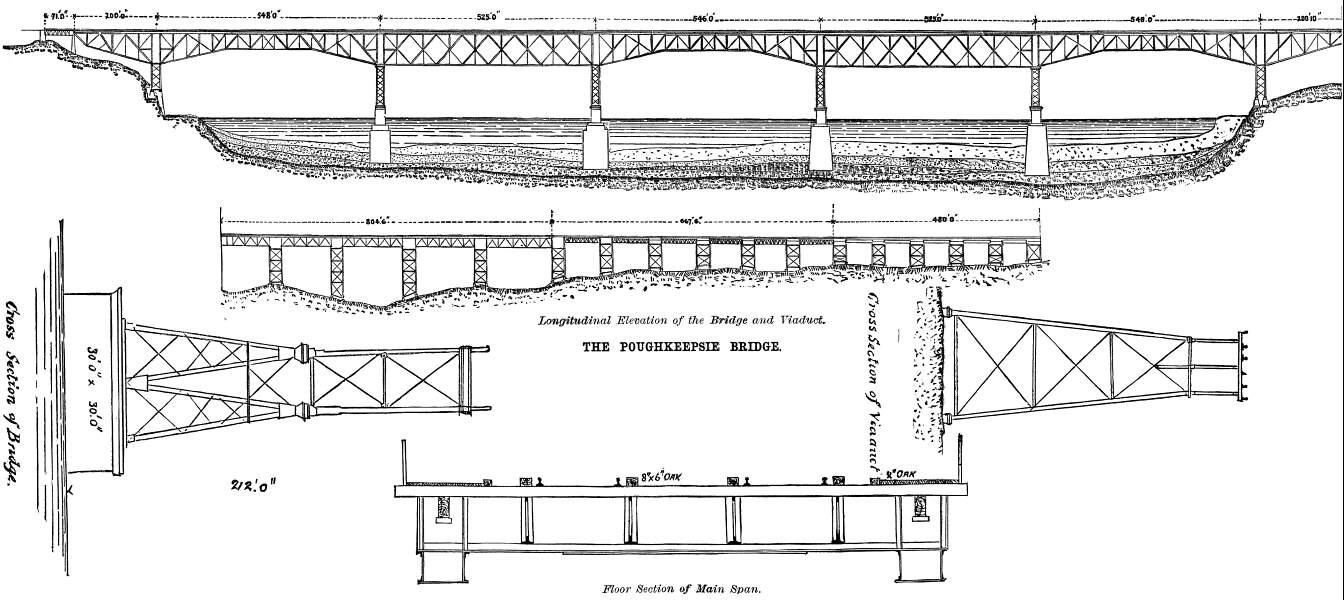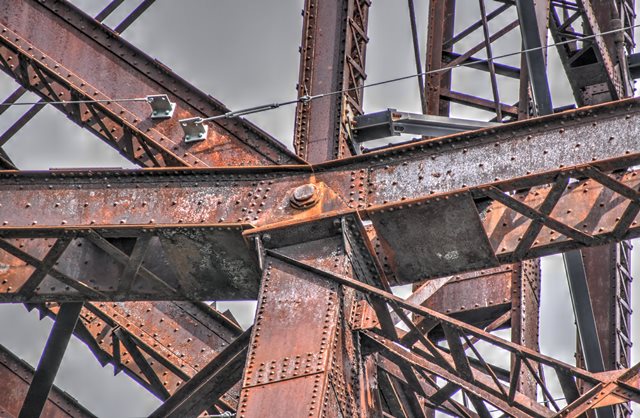We Recommend:
Bach Steel - Experts at historic truss bridge restoration.
BridgeHunter.com Phase 1 is released to the public! - Visit Now
Walkway over the Hudson
Poughkeepsie Railroad Bridge

Primary Photographer(s): Nathan Holth
Bridge Documented: September 5, 2019
Railroad (Walkway over the Hudson, Hudson Valley Rail-Trail) Over Hudson River and Various Streets and Railroads
Poughkeepsie and Highland: Dutchess County, New York and Ulster County, New York: United States
Metal Cantilever 18 Panel Pin-Connected Warren Deck Truss, Fixed and Approach Spans: Metal Pin-Connected Warren Deck Truss, Fixed
1888 By Builder/Contractor: Union Bridge Company of Athens, Pennsylvania and Buffalo, New York
2009
548.0 Feet (167 Meters)
6,767.0 Feet (2062.6 Meters)
35 Feet (10.67 Meters)
7 Main Span(s) and 35 Approach Span(s)
Not Applicable

View Information About HSR Ratings
Bridge Documentation
View Historic American Engineering Record (HAER) Documentation For This Bridge
HAER Data Pages, PDF
View Detailed Paper About This Bridge From Transactions of ASCE
View Two Historical Books Planning For Construction of this Bridge
View Historical Articles About This Bridge
View National Register of Historic Places Nomination Form For This Bridge
View The Official Walkway Over The Hudson Website
This is one of the most significant historic bridges in the country. It is one of a tiny number of surviving early large-scale iron/steel cantilever truss bridges. The successful construction of this bridge and others of the period inspired decades of cantilever truss bridge construction over halfway into the 20th century. See this bridge's page for an overview of early cantilever truss bridges. While the Poughkeepsie Railroad Bridge was not the earliest example, nor the longest-spanning example, it was noted for its long length and use of multiple cantilever/anchor spans.
As originally constructed, the bridge had two truss lines, as most traditional truss bridges do. In 1907, a third truss line was added in between the two outside trusses to strengthen the bridge. This process of adding a third truss line was not unique; other deck truss railroad bridges elsewhere in the country were sometimes strengthened in this manner. Some of the shorter approach girders and trusses on the bridge were also replaced with new plate girder spans.
This bridge was abandoned after a fire on the deck on May 8, 1974. The future of the bridge was in question for many years, until an amazing project to convert this enormous bridge for pedestrian use was completed, with the redecked bridge being opened as the Walkway over the Hudson on October 3, 2009. One of the features of this walkway is an elevator along the east bank of the river that takes visitors directly to the bridge deck. This elevator has glass windows affording a unique close-up view of one of the cantilever truss spans.
Above: Historical drawing of bridge.
Above: Historical photo showing bridge construction including massive falsework for an anchor span. The anchor spans required falsework for construction, but the cantilever spans could be built without falsework due to the cantilever design.
Above: Historical photo showing bridge construction of a cantilever span.
Above: Early proposed (never built) design for the bridge.
A later proposed (never built) design for the bridge.
![]()
Photo Galleries and Videos: Walkway over the Hudson
Structure Overview
Original / Full Size PhotosA collection of overview photos that show the bridge as a whole and general areas of the bridge. This gallery offers photos in the highest available resolution and file size in a touch-friendly popup viewer.
Alternatively, Browse Without Using Viewer
![]()
Structure Details
Original / Full Size PhotosA collection of detail photos that document the parts, construction, and condition of the bridge. This gallery offers photos in the highest available resolution and file size in a touch-friendly popup viewer.
Alternatively, Browse Without Using Viewer
![]()
Structure Overview
Mobile Optimized PhotosA collection of overview photos that show the bridge as a whole and general areas of the bridge. This gallery features data-friendly, fast-loading photos in a touch-friendly popup viewer.
Alternatively, Browse Without Using Viewer
![]()
Structure Details
Mobile Optimized PhotosA collection of detail photos that document the parts, construction, and condition of the bridge. This gallery features data-friendly, fast-loading photos in a touch-friendly popup viewer.
Alternatively, Browse Without Using Viewer
![]()
Maps and Links: Walkway over the Hudson
Coordinates (Latitude, Longitude):
Search For Additional Bridge Listings:
Bridgehunter.com: View listed bridges within 0.5 miles (0.8 kilometers) of this bridge.
Bridgehunter.com: View listed bridges within 10 miles (16 kilometers) of this bridge.
Additional Maps:
Google Streetview (If Available)
GeoHack (Additional Links and Coordinates)
Apple Maps (Via DuckDuckGo Search)
Apple Maps (Apple devices only)
Android: Open Location In Your Map or GPS App
Flickr Gallery (Find Nearby Photos)
Wikimedia Commons (Find Nearby Photos)
Directions Via Sygic For Android
Directions Via Sygic For iOS and Android Dolphin Browser
USGS National Map (United States Only)
Historical USGS Topo Maps (United States Only)
Historic Aerials (United States Only)
CalTopo Maps (United States Only)







